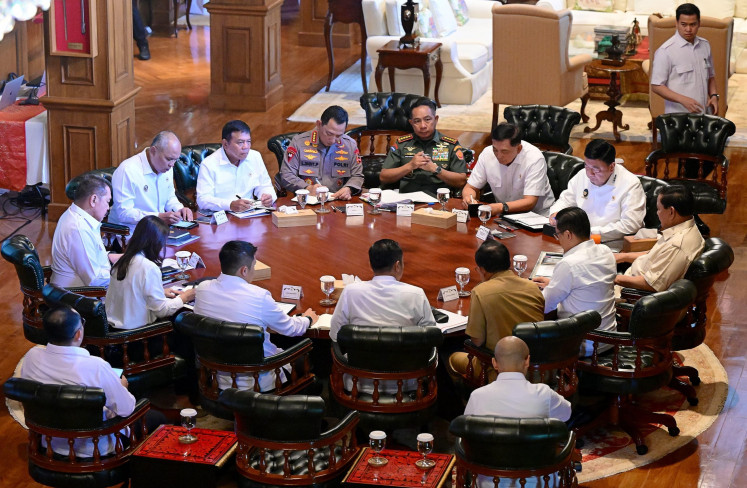Popular Reads
Top Results
Can't find what you're looking for?
View all search resultsPopular Reads
Top Results
Can't find what you're looking for?
View all search resultsOil output cuts inevitable, but at what price?
Oil is witnessing an unprecedented, simultaneous demand and supply shock that has the potential to send prices further down, as the world runs out of space to store supplies coming to a market that has seen demand crash due to the COVID-19 pandemic
Change text size
Gift Premium Articles
to Anyone
O
il is witnessing an unprecedented, simultaneous demand and supply shock that has the potential to send prices further down, as the world runs out of space to store supplies coming to a market that has seen demand crash due to the COVID-19 pandemic.
The origin of the current carnage began with the collapse of the Organization of the Petroleum Exporting Countries (OPEC)+ coalition’s discussions on March 6, when Russia failed to agree to a Saudi call for a deeper oil production cut from the group.
The meeting ended with the Saudis completely backing out of production cuts and promising to flood the market with supply starting April 1. They followed that decision with an aggressive cut in the price of their crude to make it more attractive to buyers.
Oil prices fell over 20 percent in the immediate aftermath and have found little support since. Brent and NYMEX crude futures prices are now down by around 60 percent since the start of the year and were trading in the mid- to low US$20 per barrel at the time of writing.
In early March, COVID-19 was an epidemic and was restricted mainly to countries in Asia. What oil producers did not anticipate back then was the destructive trajectory the virus would take.
COVID-19 has since become a pandemic and affected over 1 million people all over the world. It has led to mass lockdowns of countries and brought the world’s more powerful economies to a grinding halt. The United States saw record high jobless claims of 6.6 million on Thursday — a figure that has doubled within a week.
S&P Global Platts Analytics expects global oil demand to contract by 4.5 million barrels per day (bpd) in 2020 and has said that the outlook remains negative with persistent downside risks. Demand in Asia is expected to shrink by 3 million bpd in the first half of 2020. In the second quarter, the market is expected to be oversupplied by 15 million bpd.
“Over the next few months, S&P Global Platts Analytics sees global ‘massive’ crude stock builds of 1 billion barrels in its worse global pandemic case scenario, relative to end-February levels,” according to Kang Wu, head of analytics at Asia at S&P Global Platts.
Potential storage totals roughly 1.4 billion barrels, implying that the industry will approach maximum limits in May unless production is curtailed, he said.
______
Almost every oil market participant caught in the Russia-Saudi price war has been waiting to see which side blinks first.
______
Once that happens, prices could see another dramatic fall.
Platts Analytics sees Brent in the $10 to $20 per barrel range in April and May. There could be more downside from here and prices could easily dip further — whatever it takes to get significant supply off the market and quickly, Kang said.
Whiting Petroleum, a prominent US shale producer, recently declared bankruptcy, and capex cut announcements are rampant. Nearly 60 global upstream operators — a bulk of them in the US and Canada — have announced 25 to 30 percent cuts to their 2020 spending plans.
The current low-priced environment is putting roughly 5 million bpd of high cost crude production at risk of being shut in, according to Platts Analytics. But with oversupply of 15 million bpd and tanks fast filling up, this is nearly not enough. Platts Analytics believes Brent prices will need to fall to the low $10 per barrel to force immediate supply curtailment.
Almost every oil market participant caught in the Russia-Saudi price war has been waiting to see which side blinks first. Both have the ammunition to withstand low oil prices for some time; Russia with its flexible exchange rates and progressive tax structure and the Saudis with low debt and one of the lowest production costs in the world.
But the dire state of the market is nudging them closer to the negotiating table, helped with a string of mediators including United States President Donald Trump, who is struggling to contain the wreckage caused to the domestic oil industry by low oil prices.
US President Trump said on Thursday that he had spoken with Saudi Crown Prince Mohammed bin Salman, who had in turn called Russian President Vladimir Putin to heal their oil market rift. He went on to say that he expected a production cut agreement of 10 million bpd to 15 million bpd, a tweet that sent prices soaring 25 percent.
That figure, however, was not backed up and the Kremlin denied that President Putin had spoken with the crown prince.
Notwithstanding a conversation between Putin and Bin Salman, President Trump’s diplomacy has led to Saudi Arabia calling for an “urgent meeting” of the OPEC+ alliance and other producers to negotiate a deal on output cuts.
But with the scars from earlier agreements, during which the Saudis bore a lion’s share of the production cuts, yet to heal, the kingdom has categorically said that it was “seeking a fair agreement that will restore the desired balance to the oil markets” and indicated that it wanted other countries outside the OPEC+ alliance to join the talks.
Though the meeting’s fate is unclear, what is clear is that production will have to give way sooner or later. It might benefit all if it gives way in a manner that minimizes damage to producers and allows them to bounce back once demand returns, preventing another shock further down the road.










